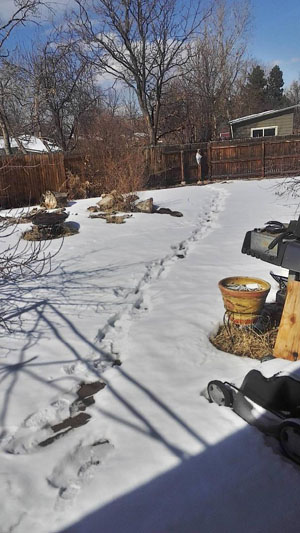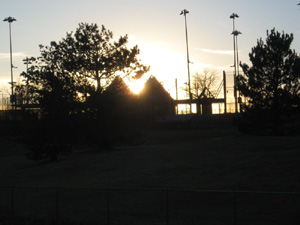Astronomy Before the Telescope
Chronology - W. Kast
December 2018
Dec 21 Determined true north without a compass
Dec 22 Construct hand held quadrant
Dec 23 Elevation observations: hand held quadrant
(sector) -- 00:00 MST Polaris 41o, 00:28 Moon 72o, 11:54 -
Sun 26.6o,
Dec 27 Construct first sundial (equatorial)
Dec 28-29 Test equatorial sundial
Dec 29 Aurorahenge - calendar predictor. Initial
"post solstice" observations.
cross staff
January 2019
Jan 1-13 Website construction, study.
Construct cross staff.
Jan 14 Observe and record Jupiter-Venus
angular separation, Sun-Venus angular separation.
Jan 19 Measured Sun-Venus angular
separation.
Jan 20 Observe lunar eclipse.
Jan 21 00:10 MST Record full moon lunar
altitude at transit. 12:15 MST Record solar altitude at solar noon.
Jan 22 Jupiter-Venus closest conjunction.
Unobserved, unfavorable weather
Jan 23-24 Work on paper astrolabe and
nocturnal celestial star dial. Both completed.
Jan 25 Studied astrolabe, sundials
Jan 26 Measured angular separation
Jupiter-Venus
Jan 28 Analemma planning. Study local noon
determination, equation of time.
Jan 30 Observed Venus-Jupiter-Lunar conjunction. Measured angles
between the three pairs. Measured Venus- Sun angle at sunrise.
February 2019
Feb 1 Measured Great Square, Orion's
belt, Betelgeuse-Rigel, Castor-Pollux angular separations. First
time measurement with nocturnal.
Feb 8 Measured Jupiter-Venus conjunction, Venus-Sun angle, Venus
obscured by clouds.
Feb 20 00:55 MST -
Record full moon lunar altitude at transit.
06:46 - Attempted Sun-Venus angular separation. Light haze prevented locating Venus just before sunrise.
Measured Moon diameter.
12:14 - Record solar altitude at transit. A day late on my full moon observations due to cloud cover.
Feb 24 Added tripod adapter to cross staff.
Nocturnal reading at 23:10.
Feb 25 Measured Jupiter-Venus conjunction, Venus-Sun
angle
MARCH 2019
Mar 17 Measured Venus-Sun angle.
Just barely. Venus extinguishes quickly at sunrise. Probably last reading
for the end of this part of the cycle. I have plans for extending these
readings by constructing and using a
dioptra to record times and
positions of Venus prior to sunrise (and later on, after sunset). I can
use this data to extrapolate the position of Venus at sunrise. By
recording the solar altitude and azimuth at sunrise, I should be able to
calculate the separation angle.
Mar 20 Vernal Equinox; Full Moon Measured solar
altitude at transit. Attempted measuring lunar rising azimuth with
astrolabe. Measured lunar altitude 1 hour after moonrise and at transit.
APRIL 2019
Apr 19 Measured lunar and solar
transit altitudes at full moon.
MAY 2019 -- A lousy cloudy cold snowy
month in Colorado.
May 26 Mounted, leveled and
aligned newly constructed analemma
(activity #4), marked first
observation at mean noon (13:00 MDT). I will try for weekly readings over
the course of the next 12 months.
May 27 Measured lunar and solar transit altitudes,
updated Lunar and Solar declinations. Published
equation of time page. Added a remark to
sundials.
June 2019
Jun 2 Sunday - Analemma mark #2
Jun 10 Monday - Analemma mark #3
Jun 16 Sunday - Analemma mark #4
Jun 17 Lunar and Solar declinations at full moon clouded
out.
Jun 24 Monday - Analemma mark #5
Jun 24 Monday - Aurorahenge Calendar predictor, observe
summer solstice sunset (late due to clouds)
Jun 30 Sunday - Analemma mark #6
July 2019
Jul 7 Sunday - Analemma mark # 7
Jul 14 Sunday - Analemma mark #8
Jul 16 Tuesday - Full Moon lunar and solar declinations
measured.
Jul 21 Sunday - Analemma mark #9
Jul 29 Monday - Analemma mark #10
August 2019
Aug 4 Sunday - Analemma mark #11
Aug 11 Sunday - Analemma mark #12
Aug 18 Sunday - Analemma mark #13
Aug 25 Sunday - Analemma mark #14
September 2019
Sep 1 Sunday - Analemma mark #15
Sep 13 Friday - Analemma mark #16, Full Moon transit altitude
measurement, solar transit measured on following day.
Sep 16 Monday - Analemma mark #17
Sep 23 - Autumnal Equinox Monday - Analemma mark #18
Sep 29 Sunday - Analemma mark #19
October 2019
Oct 6 Sunday - Analemma mark #20
Oct 13 Sunday - Analemma mark #21, Full Moon rising azimuth and
altitude measurements, Full Moon Transit altitude
measurement
Oct 14 Monday - First Observation of Venus for new cycle.
Estimated 14o angular separation from Sun using arm length estimates.
Oct 15 Tuesday - Full Moon Solar Transit altitude measurement
Oct 20
Sunday - Analemma mark #22 - hazy conditions
Oct 25 Friday - Venus/Sun angular separation measured with armillary
sphere
Oct 26 Saturday - Analemma mark #23
November 2019
Nov 3 Sunday - Analemma mark #24
Nov 9 Saturday - Analemma mark #25
Nov 12 Tuesday - Full Moon rising azimuth and altitude
measurements, Full Moon Transit altitude measurement
Nov 13 Wednesday - Analemma mark #26, full Moon solar
transit measurement
Nov 17 Sunday - Analemma mark #27
Nov 24 Sunday - Analemma mark #28, very hazy
Nov 13-30 Construction of Dioptra
December 2019
With the Winter Solstice approaching, I've accelerated my analemma
marks from weekly on Sunday to every 3-6 days weather permitting. Sundays
haven't been consistently good Sun days. Also I hope to get a better curve
as the analemma rounds the Solstice.
Dec 1 Sunday - Analemma mark #29
Dec 3 Tuesday - Venus/Sun angular separation measured with
Dioptra
Dec 7 Sunday - Analemma mark #30
Dec 9 Monday - Established
true North
landmark and benchmark at Buckley Overlook observation point.
Dec 11 Wednesday - Rising full Moon azimuth and altituded
measurements. Full Moon transit measurement.
Dec 12 Thursday - Full Moon solar transit measurement.
Analemma mark #31, overcast clouds forecast for weekend.
Dec 18 Wednesday - Anelemma mark #32 High cirrus clouds,
persistent contrails
Dec 20 Friday - Photographed setting Sun at Aurorahenge in case
Solstice clouded out. Mostly cloudy.
Dec 21 Saturday - Winter Solstice @ 21:19 MST. Solstice
Analemma mark #33 at noon MST civil time. Photographed Solstice sunset at
Aurorahenge, very clear, thin high cirrus clouds.
Dec 25 Wednesday - Snowmelt photos for measuring Solstice
Dec 26 Thursday - Analemma mark #34; Venus/Sun elongation.
Dec 29 Sunday - Analemma mark #35. Shorter interval
between analemma markings around the Winter Solstice.
January 2020
Jan 3 Friday - Analemma mark #36;
Venus/Sun elongation
Jan 4 Saturday - Using the Summer Triangle and Orion to
find Polaris
Jan 8 Wednesday - Analemma mark #37
Jan 10 Friday - Venus/Sun elongation, rising full Moon azimuth
and altitude, full Moon transit altitude and next day Solar transit altitude
Jan 14 Tuesday - (Kline) Analemma mark #38, Nocturnal readings,
Venus/Sun elongation
Jan 19 Sunday - Analemma mark #39
Jan 23 Thursday - Analemma mark #40
Jan 28 Tuesday - Analemma mark #41
February 2020
Feb 2 Sunday - Analemma mark #42; Venus/Sun elongation
(back yard)
Feb 8 Saturday - Analemma mark #43; Venus/Sun elongation,
Mercury/Sun elongation, rising full Moon azimuth and altitude, full Moon transit
altitude and next day Solar transit altitude.
Feb 14 Friday - Analemma mark #44
Feb 18 Tuesday - Analemma mark #45
The trail of the dedicated astronomer.
Footprints in the snow from my last three
analemma markings.
The analemma is on a fence post, in this
picture it is covered with a white plastic
bag for protection from the elements.
Snow on the ground from three storms
in eleven days. I've learned to take
advantage of the sunny days. |

|
February 25 Tuesday - Analemma mark #46
March 2020
March 1 Sunday - Analemma mark #47
March 6 Friday - Analemma mark #48
March 9 Monday - Full Moon transit altitude and next day Solar
transit altitude observed at home. Missed Full Moon Rising observations,
unable to travel to Buckley Overlook due to self imposed Covid-19 social
distancing restrictions.
March 15 Sunday - Analemma mark #49
March 23 Monday - Analemma mark #50
March 24 Tuesday - Venus/Sun elongation
measured with cross staff and dioptra. Day of maximum elongation.
March 31 Tuesday - Analamma mark #51
April 2020
April 4 Saturday - Analemma mark #52
April 6 Monday - Analemma mark #53; Venus/Sun elongation
measured with cross staff and dioptra
April 8 Wednesday - Full Moon transit altitude and next day
Solar transit altitude observed at home. Once again unable to make full
moon rising measurements.
April 11 Saturday - Analemma mark #54
April 11-25 I managed to neglect marking my calendar for
analemma markings during this period, so I have lost track of the count.
The year long markings will be completed in about a month. When I image
the completed analemma and crunch the data, I will correct the count.
Until then I will just record markings with no sequence number.
April 25 Saturday - Venus/Sun elongation
measured with cross staff and dioptra
April 26 Sunday - Analemma mark
April 28 Tuesday - Venus/Sun elongation measured with cross
staff
May 2020
May 1 Friday - Analemma mark
May 4 Monday - Analemma mark, Venus/Sun elongation measured
with dioptra and cross staff.
July 2020
July Using dioptra, recorded positions of naked eye comet
Neowise. Three observations on different dates.
December 2021
December 21 Tuesday Returned to Aurorahenge, observed and
photographed Winter Solstice sunset.

January 2022
Worked on activities of Astronomical League Analemma observing program.
(Equation of Time)
--Astronomy
Before the Telescope page--
--Binocrane Home--

